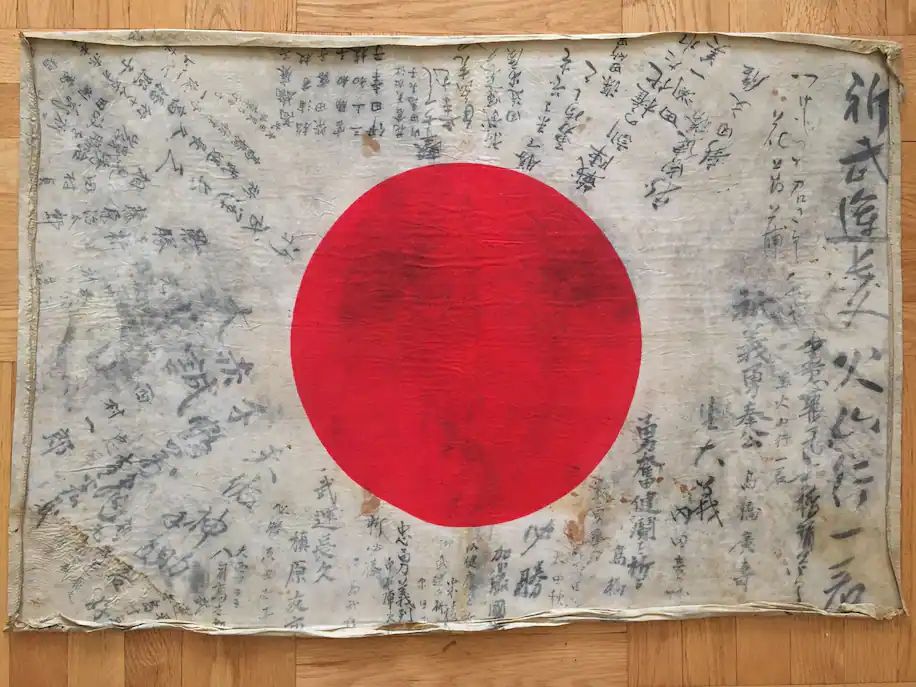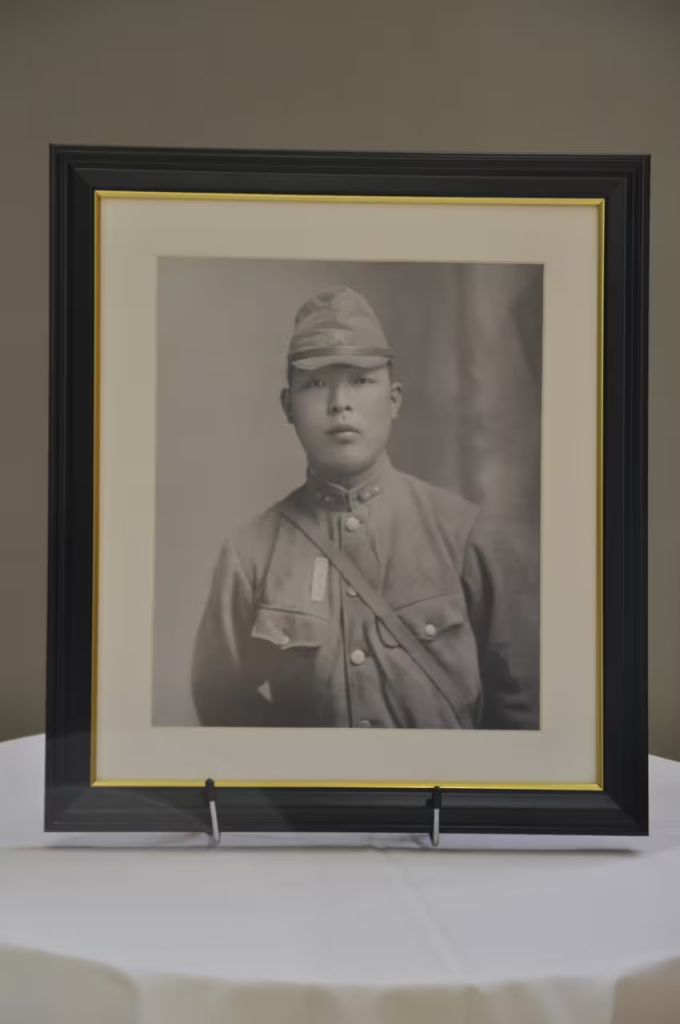
“I started to realize a while back that maybe it wasn’t the best home decor,” said Scott Stein, who donated the flag he inherited from his grandfather.
When Scott Stein was growing up in New York, he’d often visit his grandfather on Long Island and admire a Japanese flag hanging on the wall in his den.
Bernard Stein never talked about his combat experiences in Southeast Asia during World War II, but he’d brought the flag home as a war trophy after fighting with the U.S. Army’s 38th Infantry Division in the Philippines, said Scott Stein.
“I’d see it every time I went over, and I knew that flag was important to him, even though he never talked about the war,” he said. “We never knew where he got the flag, but we knew he’d been through some really heavy combat.”
About 34 years ago, Scott Stein inherited the flag after his grandfather died and hung it on his own wall for many years until he decided one day to tuck it inside a box for safekeeping. The flag included the name of the deceased soldier who had owned it, Yukikazu Hiyama.
“It’s called a good luck flag — every Japanese soldier carried one into battle, signed by family and friends in their village,” Stein said, noting that the flags were known in Japan as Yosegaki Hinomaru, interpreted as “a collection of writing under the red sun.”
“Soldiers wore them in a pouch under their uniforms,” said Stein, 55. “I started to realize a while back that maybe it wasn’t the best home decor.”

Allied soldiers often kept the flags after, per army protocol, they’d searched the bodies of dead combatants, Stein said.
Seven years ago, he said he was thinking of having the flag cleaned and restored when a friend told him there was a movement underway to reunite good luck flags with the descendants of Japanese soldiers who were killed during World War II.
Stein did some research online and learned about the OBON Society, an Oregon nonprofit devoted to finding families of the flags’ original owners. Keiko and Rex Ziak, founders of the nonprofit, agreed to help.
Stein mailed them the flag so they could begin searching for the relatives of those who had signed it for Hiyama eight decades earlier.
“It might be the only possession left of the soldier who carried it, and I wanted his ancestors to have it,” he said.
In August, Stein received word from the OBON Society that they had news after years of studying and researching the 50 names inscribed on the flag. They’d tracked down Hiyama’s only child, Tsukasa Hiyama, 81, on the Japanese island of Honshu.

Hiyama told OBON Society researchers in Japan that he never knew his father, Yukikazu Hiyama. He’d been killed in China in 1945, two years after he left to serve in the Imperial Army on the day Tsukasa was born. The family never received Yukikazu’s remains or belongings after they were notified that he’d died in action, said Rex Ziak.
“For Tsukasa, it was a fulfillment of his mother’s hope that her husband would one day return to them,” Ziak said. “After he received the flag, he took it to his mother’s tombstone and unfurled it.”
On Aug. 25, the Hiyama family held a return ceremony, inviting everyone in the community. Stars and Stripes covered the homecoming of the flag that Yukikazu Hiyama once held close to his heart.

“The return of my father’s flag has brought a significant sense of closure,” Hiyama said in an email to The Washington Post. “When I held the flag in my hands, it felt as if I could sense my father’s warmth for the first time.”
Hiyama said his mother, Asae Hiyama, struggled for years to accept that her husband had died during the war.
“We never talked much about my father,” he said. “However, since childhood, I often imagined what my father was like. What kind of person was he? What did he smell like?”
He said it was a surprise to get the flag back, and he feels a sense of relief knowing that his mother would finally be at peace.
Keiko Ziak said it’s a common reaction from those who receive lost flags from the OBON Society. She and Rex Ziak started their nonprofit in 2009, two years after a memorabilia collector mailed Keiko’s family the flag her Japanese grandfather had taken into battle in Burma, now known as Myanmar.
“We didn’t know anything about him having that flag,” she said. “Then it suddenly came back to my family. It got me thinking that I’d like to help return these flags to other families.”
With help from volunteer researchers and historians in Japan, she said the OBON Society has returned more than 600 World War II-era Japanese flags to soldiers’ families. She estimates there are probably another 50,000 good luck flags still unaccounted for in family collections and museums.
It’s often a long and tedious process to tie signatures to a particular village, said Keiko Ziak, “but these flags were like a love letter to each soldier. We never give up.”
Rex Ziak said small clues can be found on each good luck flag.
“There might be a grouping of names that we learn is common in one particular part of Japan, or maybe there’s a mention of a river or a landmark in what someone wrote,” he said.
The case involving the flag donated by Scott Stein was complicated because Tsukasa Hiyama was an only child living in a remote area of Japan, he said.
“We finally got a break when we located a family member with the same rare last name,” he said.

Stein, an agent for artists in New York City, said he was thrilled to learn that his grandfather’s flag had been returned to where it belonged.
“It feels like good karma to give it back,” he said. “I hope it helps to raise more awareness that these flags are still out there, hanging on other walls.”
“If my grandfather were still alive today, I like to think he’d have given permission for me to return the flag,” he added. “The flag has come full circle. I think he’d like that.”
BY: Cathy Free
Cathy Free is a former contributing editor for Reader’s Digest and worked as a human interest correspondent for People Magazine before joining The Post. She started her journalism career in high school as a copy clerk at The Salt Lake Tribune, where she became a feature writer and columnist. She has also worked as a daily local columnist for The Spokesman-Review in Spokane, Wash. There is nothing she enjoys more than traveling on a road she’s never been on to talk to somebody she’s never met.






